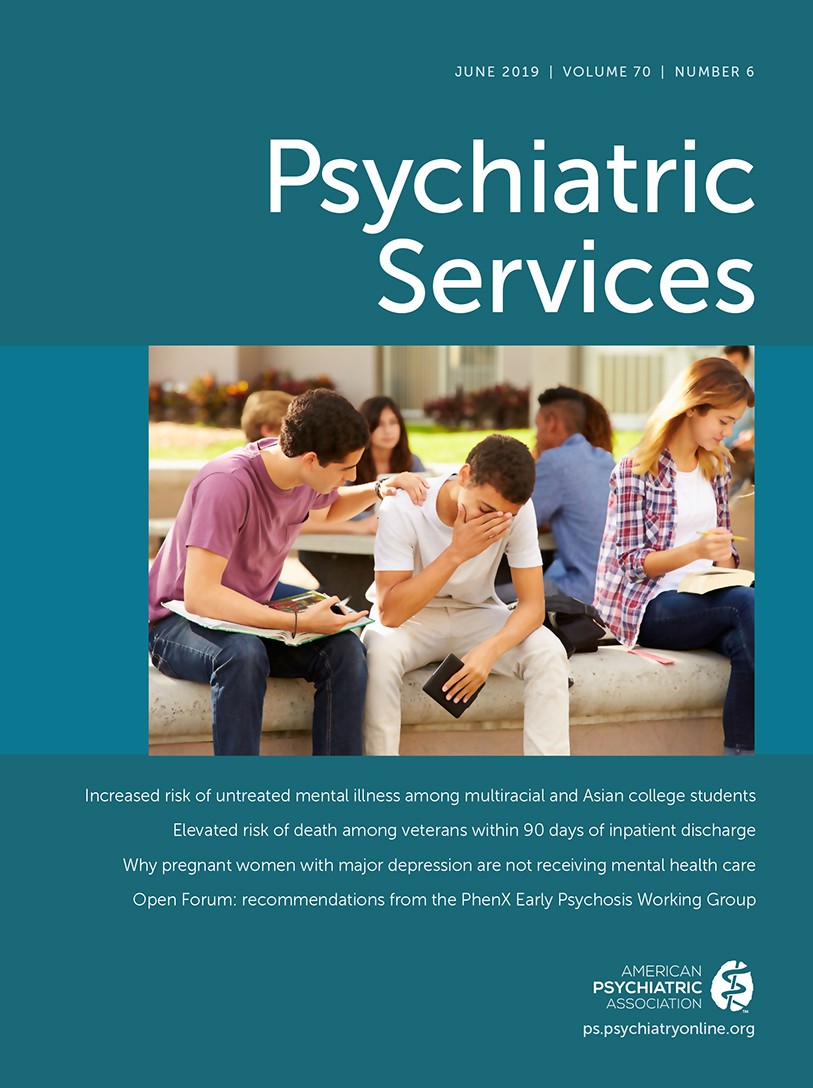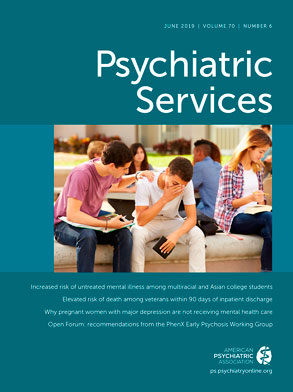Major depressive episodes are twice as common among women compared with men, with their initial onset peaking approximately around the reproductive-age years (
1). A major depressive episode that occurs during pregnancy, or in the first 12 months after delivery, is one of the most common medical conditions among women of reproductive age, with an estimated half million women experiencing it every year (
2). Therefore, perinatal mental health is considered a major public health issue in the United States (
3).
Perinatal depression often goes untreated, or is inadequately treated, and results in substantial costs and consequences for women, children, and their families (
4). Although the literature has shown that unmet mental health care need is a persistent concern in the United States (
5,
6) and has provided strategies to help parenting women with mental illness receive treatment (
2,
7), the extent to which women during pregnancy perceive an unmet need and the reasons for their unmet need have not been, to our knowledge, previously examined.
The purpose of this study was to extend what is known about perinatal mental health in several important ways. First, we compared the mental health treatment utilization patterns, unmet mental health care needs, and the forces underlying unmet mental health care needs among pregnant women with a major depressive episode with that of nonpregnant women of reproductive age who also experienced major depressive episode. Second, we extended the analysis to compare the unmet mental health care need and the underlying reasons between those who received and those who did not receive any mental health treatment. Finally, we included sociodemographic characteristics of this at-risk population.
Methods
We used data from the 2011–2016 National Survey on Drug Use and Health (NSDUH), a nationally representative survey of the noninstitutionalized population in the United States. The NSDUH was used to collect detailed information on the use of alcohol and illicit drugs, mental and substance use disorders, and utilization of a variety of behavioral health treatments (
8). Because the NSDUH provides deidentified secondary data, institutional review board approval was waived.
In the NSDUH, researchers ask respondents questions intended to assess symptoms of major depressive episode during the past year according to the criteria specified within the
DSM-IV (
9). Major depressive episode is defined as a period of at least two weeks when the person experiences symptoms such as a depressed mood or loss of interest or pleasure in daily activities. Because the focus of the study sample was restricted to reproductive-age women (18–44 years) with a major depressive episode (unadjusted pooled N=12,360), all estimates were weighted to account for NSDUH’s complex survey design and to make the estimates nationally representative (weighted pooled N≈5,728,000). Comprehensive information on the NSDUH data collection methods and survey design were published by the Substance Abuse and Mental Health Services Administration (
8).
Regardless of their mental health or treatment status, all NSDUH respondents were asked the following question: “During the past 12 months, was there a time when you needed mental health treatment or counseling but did not get it?” An indicator of perceived unmet mental health need was constructed on the basis of the response to this question, with a positive response being coded as 1 (and 0 otherwise). Respondents who reported needing treatment but not getting it were further asked to identify the reasons for not getting treatment from a list of 15 possible answers. For this analysis, these 15 possible answers were grouped into the following five categories: financial, structural, stigma, perceptions about mental health care, and other reasons. Because respondents could select multiple reasons for not getting the treatment they needed, these categories are not mutually exclusive.
The “financial” category was defined as not receiving treatment because the person could not afford the cost, his or her insurance did not cover the treatment, or his or her insurance was not enough to cover the cost of treatment. Respondents were recorded as having a “structural” barrier to treatment if they responded positively to any of the following: the person did not have any transportation, the person did not know where to go for treatment, or the treatment location was too far and inconvenient. The “stigma” rationale was assigned if the person was concerned that his or her neighbors would have a negative opinion, the person did not want others to know, the person thought it would have a negative effect on his or her job, or the person had concerns about confidentiality. Some respondents did not choose treatment because of negative “perceptions about mental health treatment.” These respondents were identified as such if the person thought he or she could handle the problem without treatment, thought he or she or did not have time for treatment, thought treatment would not help, or feared he or she would be involuntarily committed for treatment or forced to take medications. Finally, the “other reasons” category was defined as some other reason for not receiving treatment.
Mental health treatment was constructed from four dichotomous variables indicating whether in the past 12 months the respondent had received any inpatient mental health treatment (staying overnight in a hospital), any outpatient mental health treatment (treatment at an outpatient mental health clinic or center; office of a private therapist, doctor, psychologist, psychiatrist, social worker, or counselor; outpatient medical clinic; partial day treatment hospital; or day treatment program), any psychotropic medication, or any mental health treatment (whether the respondent received either outpatient or inpatient treatment or psychotropic medication for his or her mental health problem).
Using descriptive statistics (weighted percentages, standard errors, and chi-square test statistics) with a wide range of variables, we compared differences reported by pregnant and nonpregnant women who had a major depressive episode. We used Stata 14 to conduct the analyses.
Results
As shown in
Table 1, among women with a major depressive episode, only 49% of pregnant women reported receiving any mental health treatment, compared with 57% of nonpregnant women, and the differences were statistically significant (p<0.001). Prescription medication was the most prevalent form of treatment among pregnant women (40%), and 32% reported receiving any outpatient mental health services. Of pregnant women with a major depressive episode, 40% reported perceiving an unmet need for mental health treatment, regardless of whether they had received any mental health treatment. Among nonpregnant women with a major depressive episode, the rate of perceived unmet need for mental health treatment was 34% (p<0.001). The difference in perceived unmet need between pregnant and nonpregnant women with a major depressive episode was larger and more significant among those who reported receiving some mental health treatment (50% vs. 44%; p<0.001) than among those who did not receive any (31% and 28%, respectively).
For both pregnant and nonpregnant women with a major depressive episode, financial concerns were the primary reason for unmet mental health treatment need, followed by structural reasons. A similar pattern in reasons for unmet mental health treatment need was observed for the sample who received mental health treatment. However, no statistically significant difference between pregnant and nonpregnant women was observed when looking at those with no mental health treatment.
Most pregnant women with a major depressive episode who perceived an unmet need for mental health treatment had lower income, were non-Hispanic whites (66% vs. 71%, respectively), were unmarried, had children less than 18 years old, and received public health insurance benefits. Compared with nonpregnant women, they were also less likely to have a college degree or to be working (full time or part time), and they were more likely to live in households with a family income less than $20,000 (see online supplement).
Discussion
Using recent nationally representative data, we examined mental health treatment patterns, unmet mental health treatment need, and reasons for unmet needs among pregnant women with a major depressive episode in the United States. Comparisons were made with nonpregnant women to provide some perspective on the differential impact on this subgroup. The analysis showed that 51% of pregnant women with a major depressive episode did not receive any mental health treatment, and 40% of them perceived an unmet need for it regardless of whether they had received any mental health treatment. Pregnant woman with a major depressive episode were also significantly more likely to have used marijuana in the last 30 days compared with nonpregnant women (
online supplement). Similar to the previous literature (
10), this study indicated that most pregnant women did not receive any treatment despite current guidelines that call for health care providers to engage in close monitoring, evaluation, and assessment of mental health care needs of pregnant women (
1).
Treatment guidelines also recommend evidence-based psychosocial interventions and contact with psychiatrists before initiating pharmacological treatment (
1); however, we found that most pregnant women received prescription medications for mental health compared with any other form of treatment. The finding that 50% of those who received treatment but still perceived an unmet need is important and may reflect dissatisfaction with the adequacy, responsiveness, or quality of the services that some patients are receiving. When treatment is provided, pharmacological treatment is most common but may not be the ideal treatment during pregnancy. The finding that only 31% of pregnant women with a major depressive episode who did not receive any mental health treatment perceived an unmet need for it is concerning and worthy of further examination. The finding that women who perceived an unmet mental health care need were more likely to report financial concerns as the reason implies that better health insurance coverage for behavioral health services among this population might help mitigate the affordability barrier.
In the United States, research findings have documented a substantial increase in mortality among middle-age, non-Hispanic white men and women who have less than a college degree largely because of drug overdoses, suicides, and chronic liver diseases associated with alcohol consumption (
11). This demographic group is the same one highlighted here in which non-Hispanic whites with low income and less than a college degree represented the largest share of pregnant women with a major depressive episode who perceived an unmet need for mental health treatment, with a significant proportion of them reporting either misusing opioids, using marijuana, or drinking alcohol. This finding further increases concerns over their continuing lack of mental health treatment utilization, particularly given the recent policy focus on perinatal depression.
Conclusions
This study provided recent national estimates on mental health treatment, perceived unmet need, and reasons for unmet need among women with a major depressive episode. Despite current treatment guidelines, most women with a major depressive episode went without any treatment and perceived an unmet need for their mental health care. Although care and intervention before pregnancy would be ideal, greater barriers exist among pregnant women and warrant attention. Integrated health care delivery models between primary health care and behavioral health, mental health screening during pregnancy (
7), and telepsychiatry services (
12) are important tools to pursue in tackling major depressive episodes among women.

